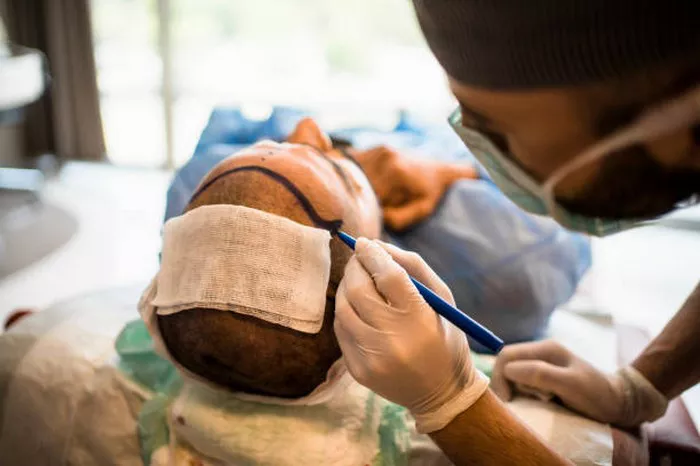Hair transplant surgery is a popular and effective solution for hair loss. However, like any surgical procedure, it comes with a recovery process. One of the most common concerns after a hair transplant is swelling. In this article, we’ll explore how long swelling lasts, what causes it, and how to manage it effectively.
What Causes Swelling After a Hair Transplant?
Swelling after a hair transplant is a natural response of the body to the surgical procedure. During the surgery, tiny incisions are made in the scalp to implant hair follicles. This process can irritate the surrounding tissues, leading to inflammation and fluid buildup. Additionally, the body sends extra blood and nutrients to the area to promote healing, which can also contribute to swelling.
How Long Does Swelling Last After a Hair Transplant?
The duration of swelling varies from person to person, but most patients experience it for 3 to 7 days.
Here’s a breakdown of the typical timeline:
Day 1-2: Initial Swelling
Swelling usually begins within the first 24-48 hours after the procedure. It often starts around the forehead and may spread to the eyes and cheeks. This is the most intense phase of swelling.
Day 3-5: Peak Swelling
Swelling typically peaks around the third day and starts to subside by the fifth day. During this time, the swelling may feel uncomfortable, but it is temporary.
Day 6-7: Gradual Reduction
By the end of the first week, most of the swelling should have gone down. However, some mild puffiness may persist for a few more days.
Beyond Day 7: Residual Swelling
In rare cases, minor swelling may linger for up to two weeks, but this is usually not noticeable to others.
Factors That Influence Swelling Duration
Several factors can affect how long swelling lasts after a hair transplant:
Surgical Technique: Follicular Unit Extraction (FUE) typically causes less swelling compared to Follicular Unit Transplantation (FUT) because it is less invasive.
Individual Healing Response: Everyone’s body heals at a different pace. Factors like age, overall health, and skin type can influence swelling duration.
Post-Operative Care: Following your surgeon’s aftercare instructions, such as keeping your head elevated and avoiding strenuous activities, can help reduce swelling.
Medications: Certain medications, like anti-inflammatory drugs, can help manage swelling more effectively.
Symptoms of Swelling After a Hair Transplant
Swelling after a hair transplant is usually accompanied by other symptoms, including:
- Redness around the transplanted area
- Tightness or discomfort in the scalp
- Mild bruising, especially around the forehead and eyes
- Itching or tingling sensations as the healing process begins
These symptoms are normal and should subside as the swelling decreases.
How to Reduce Swelling After a Hair Transplant
While swelling is a natural part of the healing process, there are several steps you can take to minimize it and speed up recovery:
1. Keep Your Head Elevated
Elevating your head, especially while sleeping, helps reduce fluid buildup in the scalp. Use an extra pillow or a recliner to keep your head above heart level for the first few days.
2. Apply Cold Compresses
Gently applying cold compresses to the forehead and around the eyes can help reduce swelling. Avoid placing ice directly on the transplanted area to prevent damage to the grafts.
3. Stay Hydrated
Drinking plenty of water helps flush out toxins and reduces fluid retention, which can contribute to swelling.
4. Avoid Strenuous Activities
Physical exertion can increase blood flow to the scalp, worsening swelling. Avoid heavy lifting, exercise, and bending over for at least a week after the procedure.
5. Follow Your Surgeon’s Instructions
Your surgeon will provide specific aftercare guidelines, including how to clean the scalp and when to resume normal activities. Adhering to these instructions is crucial for a smooth recovery.
6. Take Prescribed Medications
If your surgeon prescribes anti-inflammatory medications or antibiotics, take them as directed to manage swelling and prevent infections.
When to Seek Medical Attention
While swelling is normal, excessive or prolonged swelling could indicate a complication.
Contact your surgeon if you experience:
- Severe pain that doesn’t improve with medication
- Swelling that worsens after the first few days
- Signs of infection, such as fever, pus, or excessive redness
Long-Term Recovery After a Hair Transplant
Swelling is just one part of the recovery process.
Here’s what you can expect in the weeks and months following your hair transplant:
Week 1-2: Initial Healing
During this period, the transplanted hair follicles will begin to settle, and scabs will form around the grafts. Avoid picking or scratching the scalp to prevent dislodging the grafts.
Week 3-4: Shedding Phase
The transplanted hairs may fall out, which is a normal part of the process. This shedding makes way for new hair growth.
Month 2-3: Early Growth
New hair growth typically begins around the third month. The hair may appear thin or patchy at first but will gradually thicken over time.
Month 6-12: Full Results
By the sixth month, you should notice significant hair growth. The final results of your hair transplant will be visible by the 12-month mark.
Tips for a Smooth Recovery
To ensure the best possible outcome from your hair transplant, follow these tips:
- Avoid smoking and alcohol, as they can slow down the healing process.
- Protect your scalp from direct sunlight by wearing a hat or using sunscreen.
- Be patient and allow your body time to heal naturally.
Conclusion
Swelling after a hair transplant is a normal and temporary side effect that typically lasts 3 to 7 days. By understanding the causes, symptoms, and effective management techniques, you can ensure a smoother recovery and achieve the best results from your procedure. Always follow your surgeon’s advice and seek medical attention if you notice any unusual symptoms.
Related topic:

